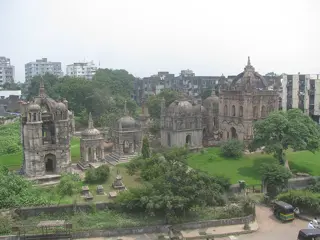Reviving Surat's Heritage Properties: Turning Cultural Gems into Tourism-Driven Real Estate
 Surat, once a hub of historical trade and cultural exchange, boasts a rich tapestry of heritage properties that now lie dormant or underutilized. By reimagining these architectural gems as boutique hospitality projects and reviving neighborhoods, Surat could carve out a niche in India’s booming tourism industry while preserving its rich history. This transformation isn’t merely aesthetic—it’s a strategic investment in the city’s future.
Surat, once a hub of historical trade and cultural exchange, boasts a rich tapestry of heritage properties that now lie dormant or underutilized. By reimagining these architectural gems as boutique hospitality projects and reviving neighborhoods, Surat could carve out a niche in India’s booming tourism industry while preserving its rich history. This transformation isn’t merely aesthetic—it’s a strategic investment in the city’s future.
Repurposing Cultural Sites: The Foundation of Boutique Hospitality
Surat’s central zones and Rander regions flaunt ornate buildings steeped in history, from merchant mansions to colonial-era structures. Converting these into boutique hotels or cultural hubs requires balancing preservation with modern amenities:
- Architectural Integrity: Keep original facades, pillars, and interior courtyards while integrating eco-friendly materials and energy-efficient systems.
- Curated Experiences: Offer heritage tours, culinary workshops, or art residencies to attract culturally inclined travelers.
- Targeted Branding: Market as one-of-a-kind stays that explore Surat’s business history, textile heritage, or diamond-trading legacy.
Reviving Historic Neighborhoods: Community-Centric Real Estate
Undoing decades of neglect in ancestral quarters like Pal Gam or Adajan involves stitching together fragmented properties into cohesive estates. Key strategies include:
1. Mixed-Use Revitalization
- Convert standalone buildings into interconnected hubs with coworking spaces, artisanal shops, and heritage restaurants.
- Modernize infrastructure with rooftop solar panels for energy-efficient systems. .
2. Phased Restoration
- Partner with local artisans to recreate period-appropriate detailing (like intricate woodwork or stone carvings).
- Implement smart lighting to highlight architectural features without altering original structures.
3. Community Engagement
- Involve local residents in decision-making through workshops or cultural committees.
- Train traditional craftspeople in heritage conservation techniques to create sustainable livelihoods.
Unveiling Real Estate Opportunities
For investors, Surat’s heritage transformation offers diversification benefits: | Aspect | Opportunity | |-------------------------|-------------------------------------| | Boutique Hotels | High occupancy with cultural travelers | | Shared Workspaces | Hosting remote workers in heritage settings | | Cultural Retail | Shops selling local textiles, handicrafts | | Event Venues | Weddings, corporate retreats in historic settings |
While returns depend on urban positioning, early movers in Surat’s central zones could capitalize on rising demand for authentic travel experiences. Challenges include navigating municipal heritage regulations, securing funding, and addressing infrastructure gaps—factors that necessitate collaboration with urban planners and cultural organizations.
Navigating Challenges and Sustainability
Balancing preservation and profitability isn’t without hurdles:
- Technical Difficulties: Reinforce old foundations, comply with modern safety codes.
- Financial Constraints: Elevated restoration costs compared to new builds; potential need for subsidies or government partnerships.
- Cultural Sensitivity: Avoid commercialization that sanitizes historic neighborhoods.
Successful projects like Gothic Heritage in Pal Gam demonstrate feasibility, blending contemporary design with preservation. For Surat to avoid gentrification pitfalls, inclusive planning is essential—prioritizing residents’ access to revitalized spaces over luxury-only accommodations.
This blend of cultural preservation and intelligent real estate investment could secure Surat’s place as a destination that celebrates its past, offering investors a unique entry point into heritage-driven property development.